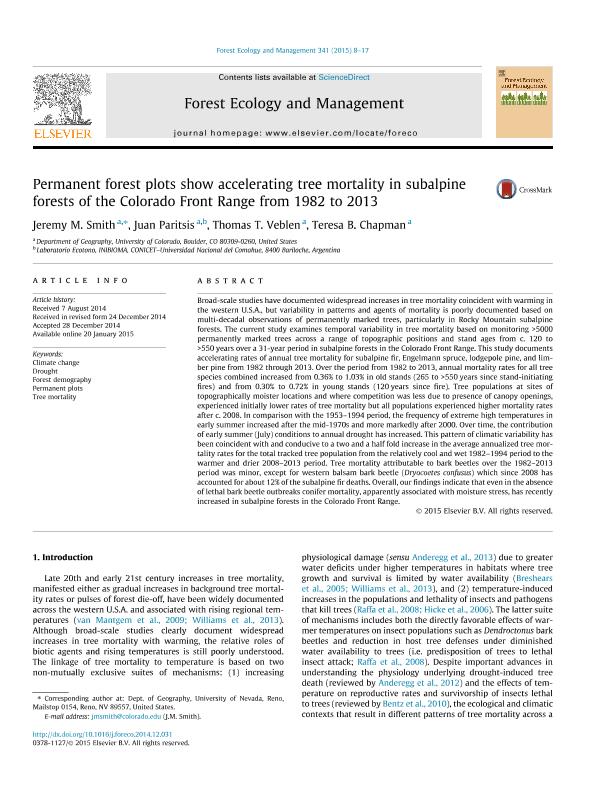Mostrar el registro sencillo del ítem
dc.contributor.author
Smith, Jeremy M.
dc.contributor.author
Paritsis, Juan

dc.contributor.author
Veblen, Thomas T.
dc.contributor.author
Chapman, Teresa B.
dc.date.available
2017-01-26T20:38:51Z
dc.date.issued
2015-04
dc.identifier.citation
Smith, Jeremy M.; Paritsis, Juan; Veblen, Thomas T.; Chapman, Teresa B.; Permanent forest plots show accelerating tree mortality in subalpine forests of the Colorado Front Range from 1982 to 2013; Elsevier Science; Forest Ecology and Management; 341; 4-2015; 8-17
dc.identifier.issn
0378-1127
dc.identifier.uri
http://hdl.handle.net/11336/12036
dc.description.abstract
Broad-scale studies have documented widespread increases in tree mortality coincident with warming in the western U.S.A., but variability in patterns and agents of mortality is poorly documented based on multi-decadal observations of permanently marked trees, particularly in Rocky Mountain subalpine forests. The current study examines temporal variability in tree mortality based on monitoring >5000 permanently marked trees across a range of topographic positions and stand ages from c. 120 to >550 years over a 31-year period in subalpine forests in the Colorado Front Range. This study documents accelerating rates of annual tree mortality for subalpine fir, Engelmann spruce, lodgepole pine, and limber pine from 1982 through 2013. Over the period from 1982 to 2013, annual mortality rates for all tree species combined increased from 0.36% to 1.03% in old stands (265 to >550 years since stand-initiating fires) and from 0.30% to 0.72% in young stands (120 years since fire). Tree populations at sites of topographically moister locations and where competition was less due to presence of canopy openings, experienced initially lower rates of tree mortality but all populations experienced higher mortality rates after c. 2008. In comparison with the 1953?1994 period, the frequency of extreme high temperatures in early summer increased after the mid-1970s and more markedly after 2000. Over time, the contribution of early summer (July) conditions to annual drought has increased. This pattern of climatic variability has been coincident with and conducive to a two and a half fold increase in the average annualized tree mortality rates for the total tracked tree population from the relatively cool and wet 1982?1994 period to the warmer and drier 2008?2013 period. Tree mortality attributable to bark beetles over the 1982?2013 period was minor, except for western balsam bark beetle (Dryocoetes confusus) which since 2008 has accounted for about 12% of the subalpine fir deaths. Overall, our findings indicate that even in the absence of lethal bark beetle outbreaks conifer mortality, apparently associated with moisture stress, has recently increased in subalpine forests in the Colorado Front Range.
dc.format
application/pdf
dc.language.iso
eng
dc.publisher
Elsevier Science

dc.rights
info:eu-repo/semantics/openAccess
dc.rights.uri
https://creativecommons.org/licenses/by-nc-nd/2.5/ar/
dc.subject
Climate Change
dc.subject
Drought
dc.subject
Tree Demography
dc.subject
Permanent Plots
dc.subject
Tree Mortality
dc.subject.classification
Ecología

dc.subject.classification
Ciencias Biológicas

dc.subject.classification
CIENCIAS NATURALES Y EXACTAS

dc.title
Permanent forest plots show accelerating tree mortality in subalpine forests of the Colorado Front Range from 1982 to 2013
dc.type
info:eu-repo/semantics/article
dc.type
info:ar-repo/semantics/artículo
dc.type
info:eu-repo/semantics/publishedVersion
dc.date.updated
2016-12-12T14:22:45Z
dc.journal.volume
341
dc.journal.pagination
8-17
dc.journal.pais
Países Bajos

dc.journal.ciudad
Ámsterdam
dc.description.fil
Fil: Smith, Jeremy M.. State University Of Colorado-boulder; Estados Unidos
dc.description.fil
Fil: Paritsis, Juan. State University Of Colorado-boulder; Estados Unidos
dc.description.fil
Fil: Veblen, Thomas T.. State University Of Colorado-boulder; Estados Unidos. Universidad Nacional del Comahue. Centro Regional Universitario Bariloche. Laboratorio de Ecotono; Argentina. Consejo Nacional de Investigaciones Científicas y Técnicas. Centro Científico Tecnológico Patagonia Norte. Instituto de Investigación en Biodiversidad y Medioambiente; Argentina
dc.description.fil
Fil: Chapman, Teresa B.. State University Of Colorado-boulder; Estados Unidos
dc.journal.title
Forest Ecology and Management

dc.relation.alternativeid
info:eu-repo/semantics/altIdentifier/url/http://www.sciencedirect.com/science/article/pii/S0378112714007476
dc.relation.alternativeid
info:eu-repo/semantics/altIdentifier/doi/http://dx.doi.org/10.1016/j.foreco.2014.12.031
Archivos asociados
